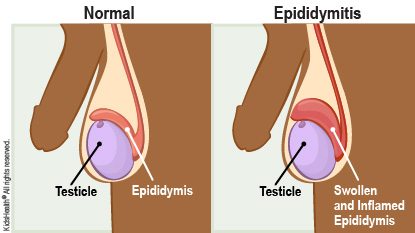Epididymitis: How to Care for Your Child
Epididymitis (ep-uh-did-ih-MYE-tiss) happens when the epididymis gets swollen and inflamed. The epididymis (ep-uh-DID-ih-miss) is the coiled tube at the back of the testicle.
Epididymitis usually gets better with antibiotic treatment and rest.


-
If the health care provider prescribed antibiotics, make sure your son takes the full course as directed.
-
If your health care provider says it's OK, you can give acetaminophen OR ibuprofen for pain. Follow the label directions on how much to give and when.
-
If your son was given a scrotal support device, have him use it as instructed.
-
Your son can apply ice wrapped in a thin towel to the area for 15–20 minutes every 3–4 hours to ease swelling. Don't put ice directly on the skin.
-
Encourage your son to rest while he recovers. He can place a towel under his scrotum to raise it.
-
Sometimes a sexually transmitted infection (STI, also called sexually transmitted disease or STD) can cause epididymitis. If an STI caused your son's epididymitis:
-
Your son should tell all past and current sexual partners to get tested and treated for infections.
-
Your son should not have sex until 1 week after he and any partners have taken all the antibiotics and symptoms have eased.
-
Your son should be tested for other STIs like HIV and syphilis.
-
Talk to your son about using condoms every time he has sex to help prevent STIs and pregnancy.

-
Your son's symptoms don't improve within 48 hours.
-
Your son gets new or worse symptoms.
-
Any symptoms remain after treatment is done.


What are the symptoms of epididymitis? Epididymitis usually causes pain and swelling of the testicle. Other symptoms can include pain when peeing or discharge from the urethra (the opening in the penis where pee comes out).
What causes epididymitis? Epididymitis can be caused by infection (including STIs), trauma, medical procedures, or problems with the way the urinary system formed.